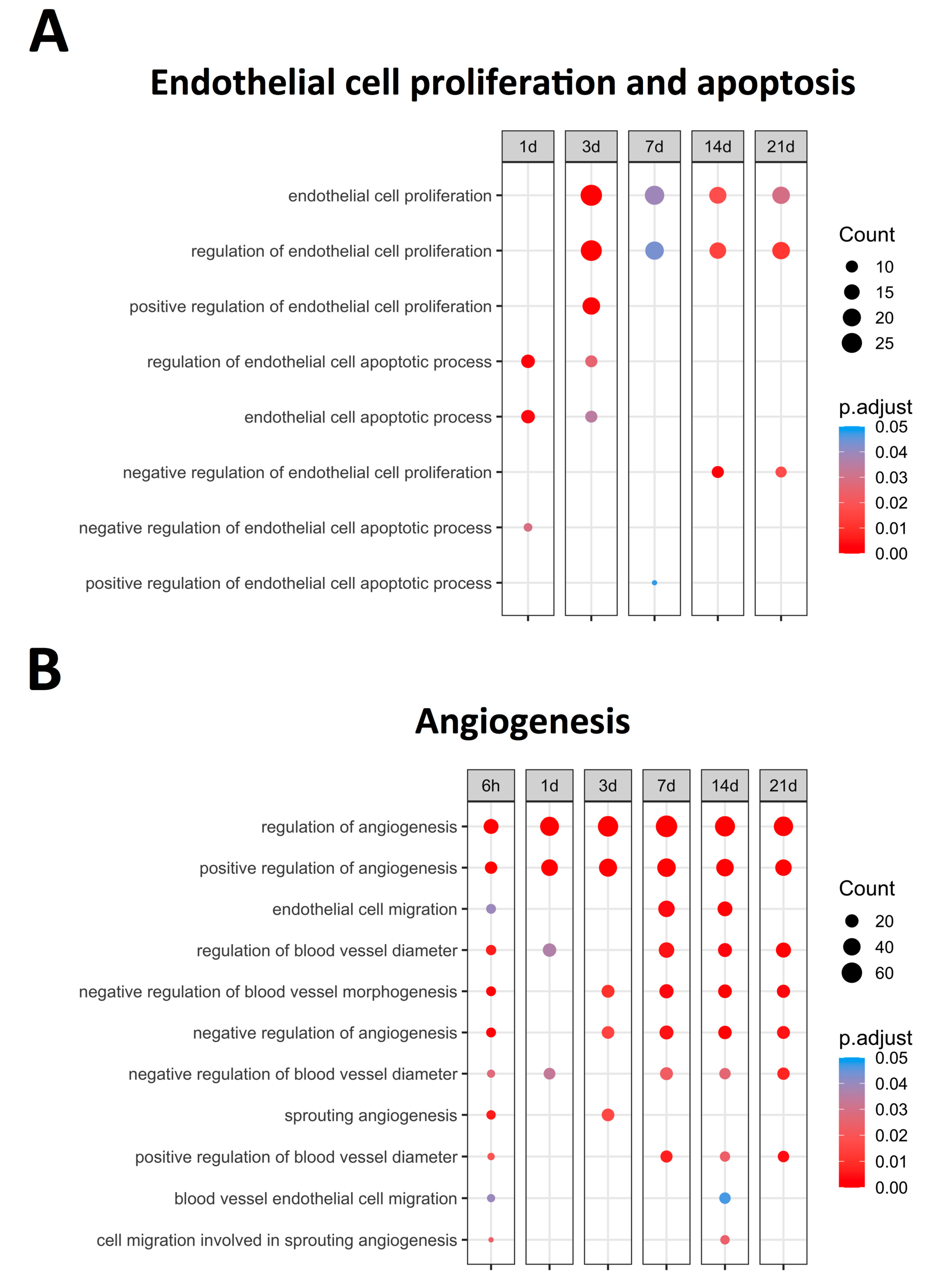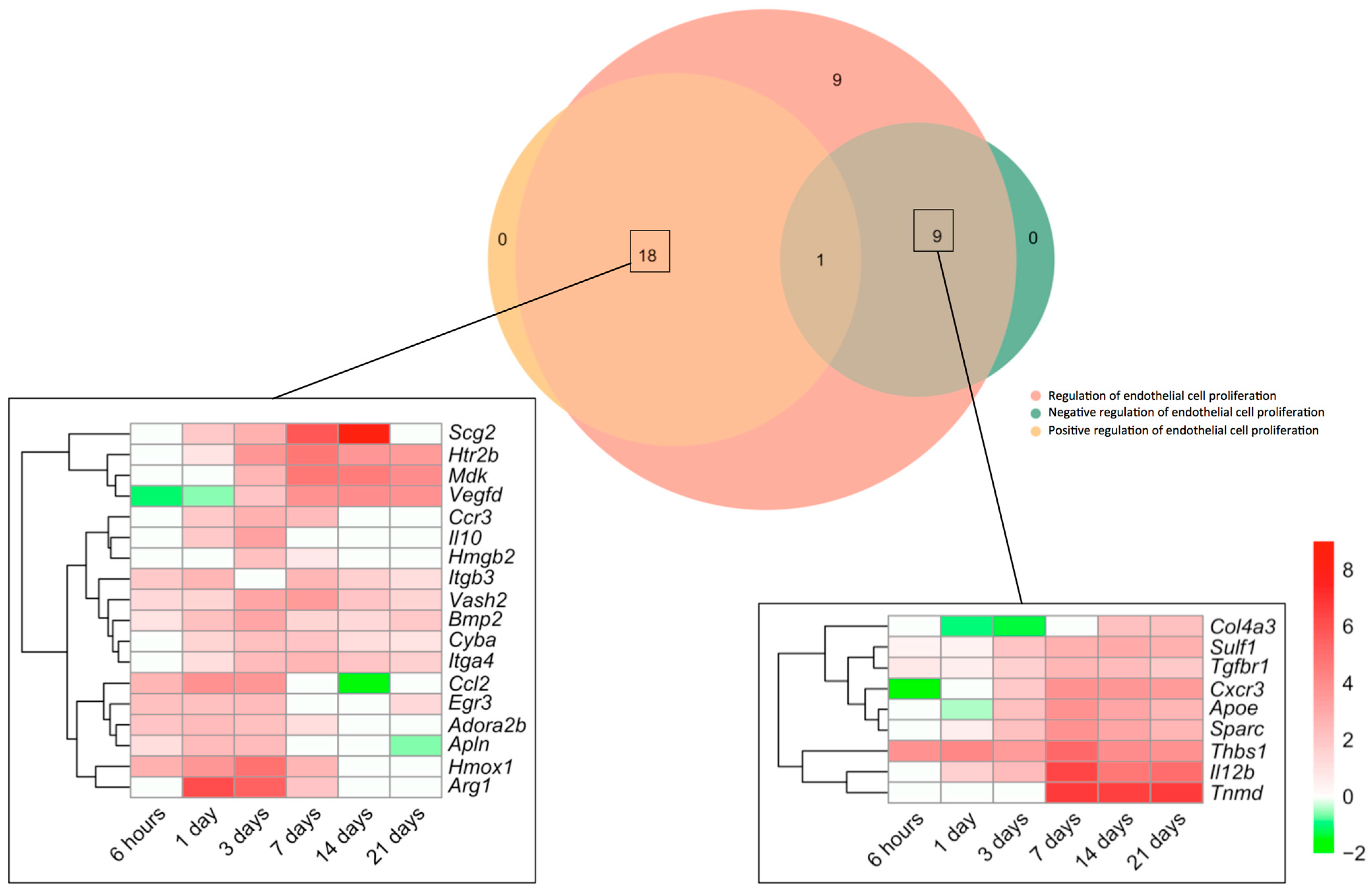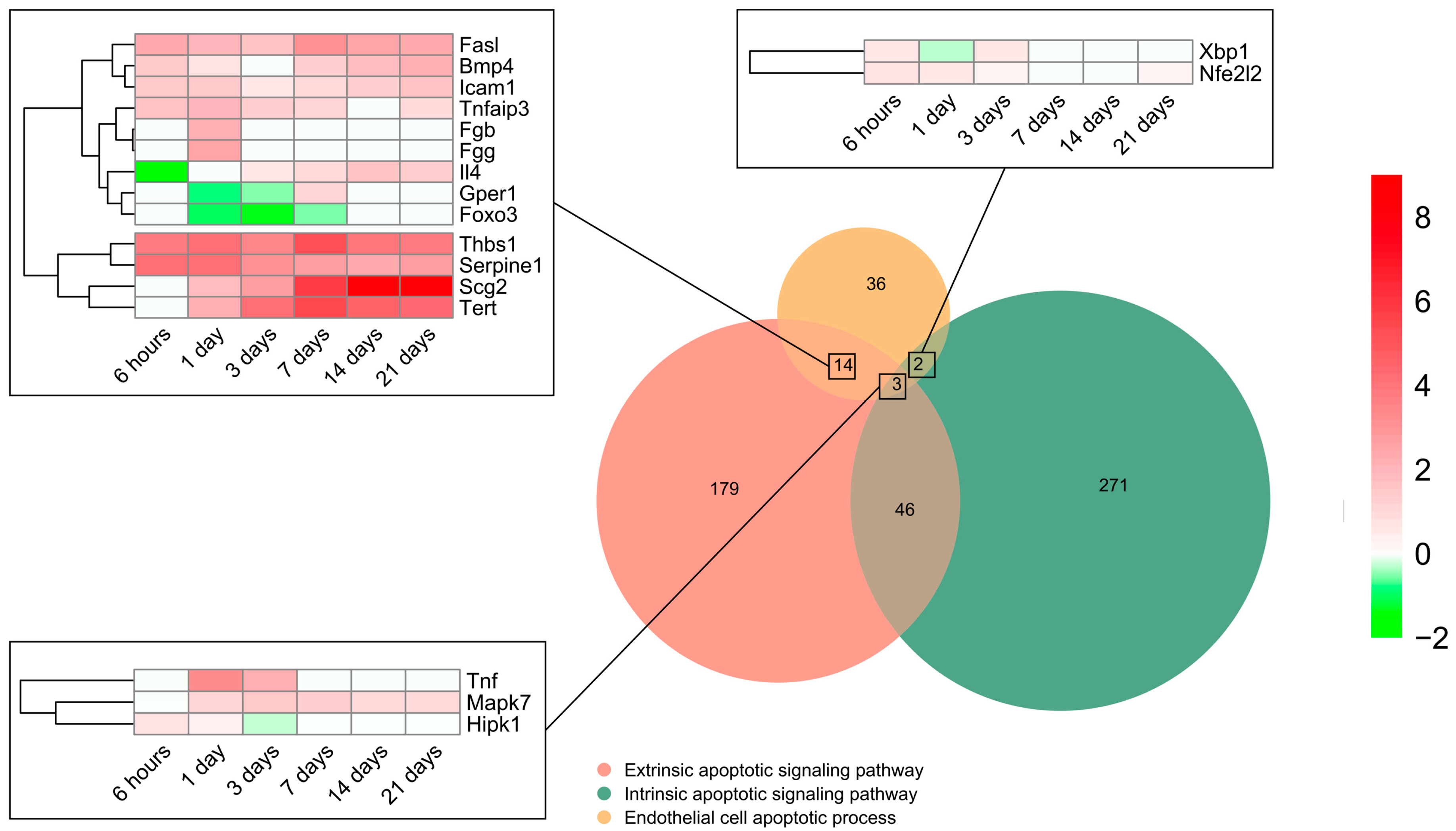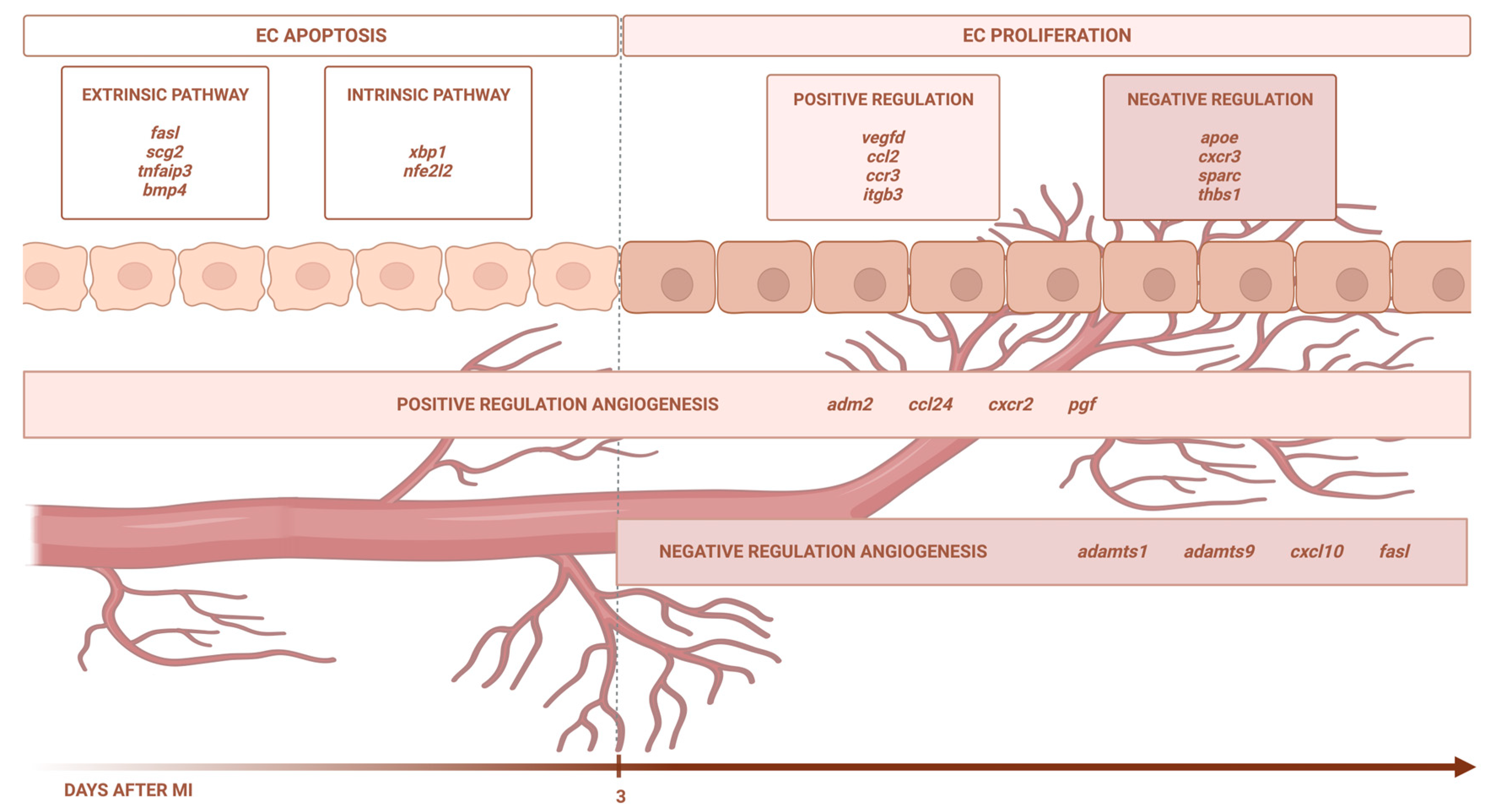Novel Targets Regulating the Role of Endothelial Cells and Angiogenesis after Infarction: A RNA Sequencing Analysis
Abstract
:1. Introduction
2. Results
2.1. Identification of the Selected Studies and Differentially Expressed Genes (DEGs)
2.2. Scrutinizing Molecular Pathways Regulating EC Viability after MI
2.3. Genes Involved in the Regulation of EC Proliferation after MI
2.4. Apoptosis Signaling Pathway Implicated in EC Apoptosis Post-MI
2.5. Regulation of Microvasculature Physiology in the MI Setting
2.6. Molecular Players in Angiogenesis Modulation following MI
2.7. Variations in the Transcriptomic Expression of Pro/Anti-Angiogenic Factors
3. Discussion
3.1. Changes in the Transcriptomic Expression of the Genes Involved in EC Viability and Proliferation following MI
3.2. Dissecting EC Apoptosis after MI
3.3. In-Depth Characterization of Genetic Targets Modulating Post-MI Angiogenesis
3.4. Limitations of the Study
4. Materials and Methods
5. Conclusions
Author Contributions
Funding
Institutional Review Board Statement
Informed Consent Statement
Data Availability Statement
Conflicts of Interest
References
- Konijnenberg, L.S.F.; Damman, P.; Duncker, D.J.; Kloner, R.A.; Nijveldt, R.; van Geuns, R.M.; Berry, C.; Riksen, N.P.; Escaned, J.; van Royen, N. Pathophysiology and diagnosis of coronary microvascular dysfunction in ST-elevation myocardial infarction. Cardiovasc. Res. 2020, 116, 787–805. [Google Scholar] [CrossRef]
- Niccoli, G.; Scalone, G.; Lerman, A.; Crea, F. Coronary microvascular obstruction in acute myocardial infarction. Eur. Heart J. 2016, 37, 1024–1033. [Google Scholar] [CrossRef]
- Hausenloy, D.J.; Chilian, W.; Crea, F.; Davidson, S.M.; Ferdinandy, P.; Garcia-Dorado, D.; van Royen, N.; Schulz, R.; Heusch, G. The coronary circulation in acute myocardial ischaemia/reperfusion injury: A target for cardioprotection. Cardiovasc. Res. 2019, 115, 1143–1155. [Google Scholar] [CrossRef]
- Ríos-Navarro, C.; Hueso, L.; Miñana, G.; Núñez, J.; Ruiz-Saurí, A.; Sanz, M.J.; Cànoves, J.; Chorro, F.J.; Piqueras, L.; Bodí, V. Coronary Serum Obtained After Myocardial Infarction Induces Angiogenesis and Microvascular Obstruction Repair. Role of Hypoxia-inducible Factor-1A. Rev. Esp. Cardiol. 2018, 71, 440–449. [Google Scholar] [CrossRef] [PubMed]
- Hollander, M.R.; de Waard, G.A.; Konijnenberg, L.S.; Meijer-van Putten, R.M.; van den Brom, C.E.; Paauw, N.; de Vries, H.E.; van de Ven, P.M.; Aman, J.; Van Nieuw-Amerongen, G.P.; et al. Dissecting the Effects of Ischemia and Reperfusion on the Coronary Microcirculation in a Rat Model of Acute Myocardial Infarction. PLoS ONE 2016, 11, e0157233. [Google Scholar]
- Ríos-Navarro, C.; Hueso, L.; Díaz, A.; Marcos-Garcés, V.; Bonanad, C.; Ruiz-Sauri, A.; Vila, J.M.; Sanz, M.J.; Chorro, F.J.; Piqueras, L.; et al. Role of antiangiogenic VEGF-A165b in angiogenesis and systolic function after reperfused myocardial infarction. Rev. Esp. Cardiol. 2021, 74, 131–139. [Google Scholar] [CrossRef] [PubMed]
- Bodi, V.; Gavara, J.; Lopez-Lereu, M.P.; Monmeneu, J.V.; de Dios, E.; Perez-Sole, N.; Bonanad, C.; Marcos-Garces, V.; Canoves, J.; Minana, G.; et al. Impact of Persistent Microvascular Obstruction Late after STEMI on Adverse LV Remodeling: A CMR Study. JACC Cardiovasc. Imaging 2023, 16, 919–930. [Google Scholar] [CrossRef]
- Badimon, L.; Borrell, M. Microvasculature Recovery by Angiogenesis After Myocardial Infarction. Curr. Pharm. Des. 2018, 24, 2967–2973. [Google Scholar] [CrossRef] [PubMed]
- Ibanez, B.; Aletras, A.H.; Arai, A.E.; Arheden, H.; Bax, J.; Berry, C.; Bucciarelli-Ducci, C.; Croisille, P.; Dall’Armellina, E.; Dharmakumar, R.; et al. Cardiac MRI Endpoints in Myocardial Infarction Experimental and Clinical Trials: JACC Scientific Expert Panel. J. Am. Coll. Cardiol. 2019, 74, 238–256. [Google Scholar] [CrossRef]
- Liu, W.; Shen, J.; Li, Y.; Wu, J.; Luo, X.; Yu, Y.; Zhang, Y.; Gu, L.; Zhang, X.; Jiang, C.; et al. Pyroptosis inhibition improves the symptom of acute myocardial infarction. Cell Death Dis. 2021, 12, 852. [Google Scholar] [CrossRef]
- Yokota, T.; McCourt, J.; Ma, F.; Ren, S.; Li, S.; Kim, T.H.; Kurmangaliyev, Y.Z.; Nasiri, R.; Ahadian, S.; Nguyen, T.; et al. Type V Collagen in Scar Tissue Regulates the Size of Scar after Heart Injury. Cell 2020, 182, 545–562.e23. [Google Scholar] [CrossRef] [PubMed]
- Park, T.J.; Park, J.H.; Lee, G.S.; Lee, J.Y.; Shin, J.H.; Kim, M.W.; Kim, Y.S.; Kim, J.Y.; Oh, K.J.; Han, B.S.; et al. Quantitative proteomic analyses reveal that GPX4 downregulation during myocardial infarction contributes to ferroptosis in cardiomyocytes. Cell Death Dis. 2019, 10, 835. [Google Scholar] [CrossRef] [PubMed]
- Arif, M.; Klevstig, M.; Benfeitas, R.; Doran, S.; Turkez, H.; Uhlén, M.; Clausen, M.; Wikström, J.; Etal, D.; Zhang, C.; et al. Integrative transcriptomic analysis of tissue-specific metabolic crosstalk after myocardial infarction. eLife 2021, 10, e66921. [Google Scholar] [CrossRef] [PubMed]
- Williams, A.L.; Walton, C.B.; Pinell, B.; Khadka, V.S.; Dunn, B.; Lee, K.; Anagaran, M.C.T.; Avelar, A.; Shohet, R.V. Ischemic heart injury leads to HIF1-dependent differential splicing of CaMK2γ. Sci. Rep. 2021, 11, 13116. [Google Scholar] [CrossRef]
- Olsen, M.B.; Hildrestrand, G.A.; Scheffler, K.; Vinge, L.E.; Alfsnes, K.; Palibrk, V.; Wang, J.; Neurauter, C.G.; Luna, L.; Johansen, J.; et al. NEIL3-Dependent Regulation of Cardiac Fibroblast Proliferation Prevents Myocardial Rupture. Cell Rep. 2017, 18, 82–92. [Google Scholar] [CrossRef]
- Ortega, M.; Ríos-Navarro, C.; Gavara, J.; de Dios, E.; Perez-Solé, N.; Marcos-Garcés, V.; Ferrández-Izquierdo, A.; Bodí, V.; Ruiz-Saurí, A. Meta-Analysis of Extracellular Matrix Dynamics after Myocardial Infarction Using RNA-Sequencing Transcriptomic Database. Int. J. Mol. Sci. 2022, 23, 15615. [Google Scholar] [CrossRef]
- Baldea, I.; Teacoe, I.; Olteanu, D.E.; Vaida-Voievod, C.; Clichici, A.; Sirbu, A.; Filip, G.A.; Clichici, S. Effects of different hypoxia degrees on endothelial cell cultures—Time course study. Mech. Ageing Dev. 2018, 172, 45–50. [Google Scholar] [CrossRef]
- Tombor, L.S.; John, D.; Glaser, S.F.; Luxán, G.; Forte, E.; Furtado, M.; Rosenthal, N.; Baumgarten, N.; Schulz, M.H.; Wittig, J.; et al. Single cell sequencing reveals endothelial plasticity with transient mesenchymal activation after myocardial infarction. Nat. Commun. 2021, 12, 681. [Google Scholar] [CrossRef]
- Kusmic, C.; Barsanti, C.; Matteucci, M.; Vesentini, N.; Pelosi, G.; Abraham, N.G.; L’Abbate, A. Up-regulation of heme oxygenase-1 after infarct initiation reduces mortality, infarct size and left ventricular remodeling: Experimental evidence and proof of concept. J. Transl. Med. 2014, 12, 89. [Google Scholar] [CrossRef]
- Shan, H.; Li, T.; Zhang, L.; Yang, R.; Li, Y.; Zhang, M.; Dong, Y.; Zhou, Y.; Xu, C.; Yang, B.; et al. Heme oxygenase-1 prevents heart against myocardial infarction by attenuating ischemic injury-induced cardiomyocytes senescence. EBioMedicine 2019, 39, 59–68. [Google Scholar] [CrossRef]
- Sumida, A.; Horiba, M.; Ishiguro, H.; Takenaka, H.; Ueda, N.; Ooboshi, H.; Opthof, T.; Kadomatsu, K.; Kodama, I. Midkine gene transfer after myocardial infarction in rats prevents remodelling and ameliorates cardiac dysfunction. Cardiovasc. Res. 2010, 86, 113–121. [Google Scholar] [CrossRef]
- Bhave, S.; Esposito, M.; Swain, L.; Qiao, X.; Martin, G.; Wadhwa, S.; Everett, K.; Kapur, N.K. Loss of bone morphogenetic protein-9 reduces survival and increases MMP activity after myocardial infarction. JACC Basic Transl. Sci. 2023, 8, 1318–1330. [Google Scholar] [CrossRef]
- Zhang, R.; Ji, Z.; Qu, Y.; Yang, M.; Su, Y.; Zuo, W.; Zhao, Q.; Ma, G.; Li, Y. Clinical value of ARG1 in acute myocardial infarction patients: Bioinformatics-based approach. Biomed. Pharmacother. 2020, 121, 109590. [Google Scholar] [CrossRef] [PubMed]
- Albrecht-Schgoer, K.; Schgoer, W.; Holfeld, J.; Theurl, M.; Wiedemann, D.; Steger, C.; Gupta, R.; Semsroth, S.; Fischer-Colbrie, R.; Beer, A.G.; et al. The angiogenic factor secretoneurin induces coronary angiogenesis in a model of myocardial infarction by stimulation of vascular endothelial growth factor signaling in endothelial cells. Circulation 2012, 126, 2491–2501. [Google Scholar] [CrossRef] [PubMed]
- Kitahara, S.; Suzuki, Y.; Morishima, M.; Yoshii, A.; Kikuta, S.; Shimizu, K.; Morikawa, S.; Sato, Y.; Ezaki, T. Vasohibin-2 modulates tumor onset in the gastrointestinal tract by normalizing tumor angiogenesis. Mol. Cancer 2014, 13, 99. [Google Scholar] [CrossRef]
- Rios-Navarro, C.; Gavara, J.; de Dios, E.; Perez-Sole, N.; Molina-Garcia, T.; Marcos-Garcés, V.; Ruiz-Sauri, A.; Bayés-Genis, A.; Carrión-Valero, F.; Chorro, F.J.; et al. Effect of serum from patients with ST-segment elevation myocardial infarction on endothelial cells. Rev. Esp. Cardiol. 2023. Online ahead of print. [Google Scholar] [CrossRef]
- Zacharia, E.; Antonopoulos, A.S.; Oikonomou, E.; Papageorgiou, N.; Pallantza, Z.; Miliou, A.; Mystakidi, V.C.; Simantiris, S.; Kriebardis, A.; Orologas, N.; et al. Plasma signature of apoptotic microvesicles is associated with endothelial dysfunction and plaque rupture in acute coronary syndromes. J. Mol. Cell. Cardiol. 2020, 138, 110–114. [Google Scholar] [CrossRef]
- Mishra, P.K.; Adameova, A.; Hill, J.A.; Baines, C.P.; Kang, P.M.; Downey, J.M.; Narula, J.; Takahashi, M.; Abbate, A.; Piristine, H.C.; et al. Guidelines for evaluating myocardial cell death. Am. J. Physiol. Heart Circ. Physiol. 2019, 317, H891–H922. [Google Scholar] [CrossRef]
- Giral, H.; Franke, V.; Moobed, M.; Müller, M.F.; Lübking, L.; James, D.M.; Hartung, J.; Kuschnerus, K.; Meteva, D.; Seppelt, C.; et al. Rapid Inflammasome Activation Is Attenuated in Post-Myocardial Infarction Monocytes. Front. Immunol. 2022, 13, 857455. [Google Scholar] [CrossRef]
- Verstrepen, L.; Verhelst, K.; van Loo, G.; Carpentier, I.; Ley, S.C.; Beyaert, R. Expression, biological activities and mechanisms of action of A20 (TNFAIP3). Biochem. Pharmacol. 2010, 80, 2009–2020. [Google Scholar] [CrossRef]
- Kirk, J.A.; Cingolani, O.H. Thrombospondins in the transition from myocardial infarction to heart failure. J. Mol. Cell. Cardiol. 2016, 90, 102–110. [Google Scholar] [CrossRef] [PubMed]
- Bär, C.; Bernardes de Jesus, B.; Serrano, R.; Tejera, A.; Ayuso, E.; Jimenez, V.; Formentini, I.; Bobadilla, M.; Mizrahi, J.; de Martino, A.; et al. Telomerase expression confers cardioprotection in the adult mouse heart after acute myocardial infarction. Nat. Commun. 2014, 5, 5863. [Google Scholar] [CrossRef]
- Oh, H.; Taffet, G.E.; Youker, K.A.; Entman, M.L.; Overbeek, P.A.; Michael, L.H.; Schneider, M.D. Telomerase reverse transcriptase promotes cardiac muscle cell proliferation, hypertrophy, and survival. Proc. Natl. Acad. Sci. USA 2001, 98, 10308–10313. [Google Scholar] [CrossRef] [PubMed]
- Pavlov, M.; Nikolić-Heitzler, V.; Babić, Z.; Milošević, M.; Kordić, K.; Ćelap, I.; Degoricija, V. Plasminogen activator inhibitor-1 activity and long-term outcome in patients with ST-elevation myocardial infarction treated with primary percutaneous coronary intervention: A prospective cohort study. Croat. Med. J. 2018, 59, 108–117. [Google Scholar] [CrossRef] [PubMed]
- Shimizu, T.; Uematsu, M.; Yoshizaki, T.; Obata, J.E.; Nakamura, T.; Fujioka, D.; Watanabe, K.; Watanabe, Y.; Kugiyama, K. Myocardial Production of Plasminogen Activator Inhibitor-1 is Associated with Coronary Endothelial and Ventricular Dysfunction after Acute Myocardial Infarction. J. Atheroscler. Thromb. 2016, 23, 557–566. [Google Scholar] [CrossRef]
- Takeshita, K.; Hayashi, M.; Iino, S.; Kondo, T.; Inden, Y.; Iwase, M.; Kojima, T.; Hirai, M.; Ito, M.; Loskutoff, D.J.; et al. Increased expression of plasminogen activator inhibitor-1 in cardiomyocytes contributes to cardiac fibrosis after myocardial infarction. Am. J. Pathol. 2004, 164, 449–456. [Google Scholar] [CrossRef]
- Liu, S.; Ding, H.; Li, Y.; Zhang, X. Molecular Mechanism Underlying Role of the XBP1s in Cardiovascular Diseases. J. Cardiovasc. Dev. Dis. 2022, 9, 459. [Google Scholar] [CrossRef] [PubMed]
- Li, Z.; Solomonidis, E.G.; Meloni, M.; Taylor, R.S.; Duffin, R.; Dobie, R.; Magalhaes, M.S.; Henderson, B.E.P.; Louwe, P.A.; D’Amico, G.; et al. Single-cell transcriptome analyses reveal novel targets modulating cardiac neovascularization by resident endothelial cells following myocardial infarction. Eur. Heart J. 2019, 40, 2507–2520. [Google Scholar] [CrossRef]
- Başyiğit, F.; Karayiğit, O.; Nurkoç, S.C.; Duyuler, S.; Duyuler, P.T. Association of serum pleiotrophin levels with acute coronary syndrome. Int. J. Cardiovasc. Acad. 2022, 8, 78–82. [Google Scholar] [CrossRef]
- Barrett, T.; Wilhite, S.E.; Ledoux, P.; Evangelista, C.; Kim, I.F.; Tomashevsky, M.; Marshall, K.A.; Phillippy, K.H.; Sherman, P.M.; Holko, M.; et al. NCBI GEO: Archive for functional genomics data sets—Update. Nucleic Acids Res. 2013, 41, D991–D995. [Google Scholar] [CrossRef]
- Langmead, B.; Salzberg, S.L. Fast gapped-read alignment with Bowtie 2. Nat. Methods 2012, 9, 357–359. [Google Scholar] [CrossRef]
- Anders, S.; Pyl, P.T.; Huber, W. HTSeq—A Python framework to work with high-throughput sequencing data. Bioinformatics 2015, 31, 166–169. [Google Scholar] [CrossRef] [PubMed]
- RStudio Team: RStudio: Integrated Development for R. 2019. RStudio Team. RStudio: Integrated Development for R. RStudio, PBC, Boston, MA, USA. 2020. Available online: https://emea01.safelinks.protection.outlook.com/?url=http%3A%2F%2Fwww.rstudio.com%2F&data=05%7C01%7C%7Ca133c54cc1a94eb14d3208dbd611069c%7C84df9e7fe9f640afb435aaaaaaaaaaaa%7C1%7C0%7C638339140828995481%7CUnknown%7CTWFpbGZsb3d8eyJWIjoiMC4wLjAwMDAiLCJQIjoiV2luMzIiLCJBTiI6Ik1haWwiLCJXVCI6Mn0%3D%7C3000%7C%7C%7C&sdata=UQl8ltbnGuMxZIwVHWevjTwVWF9czVZrfT%2B%2FPgRdeOA%3D&reserved=0 (accessed on 24 October 2023).
- Love, M.I.; Huber, W.; Anders, S. Moderated estimation of fold change and dispersion for RNA-seq data with DESeq2. Genome Biol. 2014, 15, 550. [Google Scholar] [CrossRef] [PubMed]
- Yu, G.; Wang, L.G.; Han, Y.; He, Q.Y. ClusterProfiler: An R package for comparing biological themes among gene clusters. OMICS J. Integr. Biol. 2012, 16, 284–287. [Google Scholar] [CrossRef]
- Mi, H.; Muruganujan, A.; Ebert, D.; Huang, X.; Thomas, P.D. PANTHER version 14: More genomes, a new PANTHER GO-slim and improvements in enrichment analysis tools. Nucleic Acids Res. 2019, 47, D419–D426. [Google Scholar] [CrossRef] [PubMed]
- Wickham, H. ggplot2: Elegant Graphics for Data Analysis; Springer: New York, NY, USA, 2016. [Google Scholar]
- Kolde, R. Pheatmap: Pretty Heatmaps [Software]. 2015. Available online: https://emea01.safelinks.protection.outlook.com/?url=https%3A%2F%2Fgithub.com%2Fraivokolde%2Fpheatmap&data=05%7C01%7C%7Ca133c54cc1a94eb14d3208dbd611069c%7C84df9e7fe9f640afb435aaaaaaaaaaaa%7C1%7C0%7C638339140828995481%7CUnknown%7CTWFpbGZsb3d8eyJWIjoiMC4wLjAwMDAiLCJQIjoiV2luMzIiLCJBTiI6Ik1haWwiLCJXVCI6Mn0%3D%7C3000%7C%7C%7C&sdata=Ryqf19M6%2Fx1Al3W%2F7Zr2jTtshGJnmnVJA3tTjFlOGLQ%3D&reserved=0 (accessed on 1 August 2023).
- Larsson, J. eulerr: Area-Proportional Euler and Venn Diagrams with Ellipses. 2022. R Package Version 7.0.0. Available online: https://CRAN.R-project.org/package=eulerr (accessed on 1 August 2023).






| Dataset | Study | Number of Animals |
|---|---|---|
| GSE153494 | [10] | 12 |
| GSE151834 | [11] | 20 |
| GSE114695 | [12] | 18 |
| GSE153485 | [13] | 20 |
| GSE154072 | N/A | 3 |
| GSE153493 | N/A | 9 |
| GSE104187 | [14] | 8 |
| GSE83350 | [15] | 2 |
| Total | 92 | |
| Gene | 3 Days of Ischemia | 7 Days of Ischemia | 14 Days of Ischemia | 21 Days of Ischemia | ||||||
|---|---|---|---|---|---|---|---|---|---|---|
| Log2-Fold Change | Adjusted p-Value | Log2-Fold Change | Adjusted p-Value | Log2-Fold Change | Adjusted p-Value | Log2-Fold Change | Adjusted p-Value | |||
| Regulation of endothelial cell proliferation (GO: 0001936) | Endothelial cell proliferation (GO: 0001935) | apoe | 2 | 1.37 × 10−35 | 4 | 5.03 × 10−71 | 3 | 2.94 × 10−25 | 3 | 2.06 × 10−36 |
| il12b | 2 | 0.001 | 6 | 5.77 × 10−15 | 5 | 1.87 × 10−5 | 5 | 5.55 × 10−10 | ||
| hmox1 | 5 | 1.65 × 10−35 | 3 | 5.49 × 10−8 | - | - | - | - | ||
| cyba | 2 | 1.64 × 10−35 | 2 | 1.37 × 10−21 | 1 | 0.0002 | 0.92 | 3.96 | ||
| aldh1a2 | 3 | 7.91 × 10−19 | 1 | 0.0049 | - | - | - | - | ||
| il10 | 3 | 8.69 × 10−7 | - | - | - | - | - | - | ||
| sulf1 | 2 | 3.29 × 10−66 | 3 | 3.49 × 10−85 | 3 | 8.70 × 10−51 | 3 | 4.86 × 10−88 | ||
| adora2b | 2 | 1.27 × 10−15 | 1 | 0.0002 | - | - | - | - | ||
| sparc | 2 | 7.14 × 10−46 | 4 | 1.42 × 10−95 | 3 | 4.03 × 10−35 | 3 | 7.79 × 10−45 | ||
| arg1 | 5 | 2.22 × 10−15 | 2 | 0.02 | - | - | - | - | ||
| itgb3 | 3 | 2.90 × 10−46 | 3 | 4.44 × 10−24 | 2 | 1.25 × 10−5 | 1 | 4.72 × 10−6 | ||
| tnf | 2.17 | 3.22 × 10−8 | - | - | - | - | - | - | ||
| htr2b | 4 | 8.53 × 10−30 | 5 | 1.58 × 10−38 | 4 | 3.92 × 10−13 | 3 | 1.17 × 10−21 | ||
| itga4 | 2 | 1.93 × 10−30 | 3 | 3.91 × 10−26 | 2 | 2.47 × 10−8 | 2 | 6.64 × 10−12 | ||
| mdk | 3 | 1.09 × 10−33 | 5 | 2.93 × 10−82 | 5 | 3.76 × 10−44 | 4 | 7.04 × 10−67 | ||
| bmp2 | 3 | 1.70 × 10−41 | 2 | 2.63 × 10−8 | 1 | 0.001 | 2 | 1.38 × 10−11 | ||
| vegfd | 2 | 1.63 × 10−21 | 4 | 1.46 × 10−57 | 4 | 4.99 × 10−33 | 4 | 4.85 × 10−60 | ||
| egr3 | 2 | 6.23 × 10−10 | - | - | - | - | 1 | 0.003 | ||
| ccl12 | 3 | 6.80 × 10−20 | 1 | 7.22 × 10−5 | - | - | 1 | 0.0007 | ||
| ccl2 | 4 | 9.61 × 10−26 | - | - | −1 | 0.02 | - | - | ||
| ccr3 | 3 | 1.77 × 10−6 | 2 | 0.0003 | - | - | - | - | ||
| apln | 2 | 9.33 × 10−24 | - | - | - | - | −0.627 | 0.02 | ||
| vash2 | 3 | 2.15 × 10−22 | 4 | 9.39 × 10−22 | 2 | 0.0002 | 1 | 0.0002 | ||
| thbs1 | 3 | 2.88 × 10−24 | 5 | 4.94 × 10−39 | 4 | 5.43 × 10−13 | 4 | 2.84 × 10−23 | ||
| scg2 | 3 | 0.0002 | 6 | 1.38 × 10−13 | 9 | 1.76 × 10−17 | 9 | 4.23 × 10−30 | ||
| hmgb2 | 2 | 2.84 × 10−23 | 0.765 | 0.008 | - | - | - | - | ||
| gdf2 | 4 | 5.39 × 10−4 | 8 | 2.25 × 10−9 | 9 | 1.42 × 10−7 | 10 | 4.36 × 10−15 | ||
| tgfbr1 | 2 | 1.99 × 10−32 | 2 | 4.62 × 10−50 | 2 | 1.97 × 10−23 | 2 | 1.52 × 10−28 | ||
| igf1 | 2 | 2.04 × 10−20 | 4 | 1.95 × 10−51 | 3 | 3.19 × 10−19 | 2 | 4.35 × 10−24 | ||
| thbs4 | 2 | 2.24 × 10−14 | 4 | 3.03 × 10−47 | 4 | 6.06 × 10−24 | 4 | 1.56 × 10−50 | ||
| ecm1 | 2 | 1.60 × 10−26 | 3 | 2.69 × 10−34 | 2 | 2.47 × 10−15 | 2 | 5.88 × 10−27 | ||
| tnmd | - | - | 7 | 7.98 × 10−15 | 7 | 8.13 × 10−9 | 7 | 4.29 × 10−15 | ||
| cxcr3 | 2 | 1.22 × 10−6 | 4 | 5.03 × 10−21 | 4 | 4.30 × 10−11 | 3 | 1.53 × 10−17 | ||
| col4a3 | −1 | 2.36 × 10−6 | - | - | −4 | 1.17 × 10−8 | 2 | 6.80 | ||
| lep | - | - | - | - | - | - | 7 | 0.0007 | ||
| bmp4 | - | - | 1 | 2.79 × 10−7 | 2 | 1.15 × 10−8 | 2 | 5.83 × 10−22 | ||
| loxl2 | 3 | 3.29 × 10−66 | 4 | 5.20 × 10−67 | 2 | 2.43 × 10−15 | 2 | 4.03 × 10−19 | ||
| bmper | 2 | 2.80 × 10−19 | 3 | 2.95 × 10−37 | 1 | 0.0004 | 1 | 3.00 × 10−17 | ||
| Gene | 1 Day of Ischemia | 3 Days of Ischemia | ||||
|---|---|---|---|---|---|---|
| Log2-Fold Change | Adjusted p-Value | Log2-Fold Change | Adjusted p-Value | |||
| Endothelial cell apoptotic process (GO: 0072577) | Regulation of endothelial cell apoptotic process (GO: 200035) | fasl | 2.07 | 0.0001 | 1.55 | 0.01 |
| angptl4 | 3.28 | 1.62 × 10−23 | 2.78 | 1.45 × 10−11 | ||
| tnfaip3 | 2.06 | 1.75 × 10−22 | 1.26 | 1.95 × 10−6 | ||
| tert | 2.26 | 3.77 × 10−6 | 4.18 | 1.67 × 10−17 | ||
| tnf | 3.24 | 3.18 × 10−23 | 2.17 | 3.22 × 10−8 | ||
| fgf21 | 2.59 | 0.005 | - | - | ||
| cd40lg | 2.84 | 0.005 | - | - | ||
| fgb | 2.22 | 0.02 | - | - | ||
| fgg | 2.53 | 0.02 | - | - | ||
| ccl12 | 2.04 | 5.07 × 10−17 | 2.70 | 6.79 × 10−20 | ||
| serpine1 | 4.23 | 3.35 × 10−78 | 3.03 | 6.65 × 10−27 | ||
| thbs1 | 4.17 | 2.62 × 10−52 | 3.47 | 2.88 × 10−24 | ||
| col18a1 | 1.07 | 9.53 × 10−15 | 2.88 | 1.80 × 10−67 | ||
| il10 | 1.81 | 0.003 | 3.22 | 8.68 × 10−7 | ||
| itga4 | 1.14 | 7.81 × 10−11 | 2.38 | 1.93 × 10−30 | ||
| scg2 | 1.87 | 0.006 | 2.73 | 0.0001 | ||
Disclaimer/Publisher’s Note: The statements, opinions and data contained in all publications are solely those of the individual author(s) and contributor(s) and not of MDPI and/or the editor(s). MDPI and/or the editor(s) disclaim responsibility for any injury to people or property resulting from any ideas, methods, instructions or products referred to in the content. |
© 2023 by the authors. Licensee MDPI, Basel, Switzerland. This article is an open access article distributed under the terms and conditions of the Creative Commons Attribution (CC BY) license (https://creativecommons.org/licenses/by/4.0/).
Share and Cite
Ortega, M.; Molina-García, T.; Gavara, J.; de Dios, E.; Pérez-Solé, N.; Marcos-Garcés, V.; Chorro, F.J.; Rios-Navarro, C.; Ruiz-Sauri, A.; Bodi, V. Novel Targets Regulating the Role of Endothelial Cells and Angiogenesis after Infarction: A RNA Sequencing Analysis. Int. J. Mol. Sci. 2023, 24, 15698. https://doi.org/10.3390/ijms242115698
Ortega M, Molina-García T, Gavara J, de Dios E, Pérez-Solé N, Marcos-Garcés V, Chorro FJ, Rios-Navarro C, Ruiz-Sauri A, Bodi V. Novel Targets Regulating the Role of Endothelial Cells and Angiogenesis after Infarction: A RNA Sequencing Analysis. International Journal of Molecular Sciences. 2023; 24(21):15698. https://doi.org/10.3390/ijms242115698
Chicago/Turabian StyleOrtega, María, Tamara Molina-García, Jose Gavara, Elena de Dios, Nerea Pérez-Solé, Victor Marcos-Garcés, Francisco J. Chorro, Cesar Rios-Navarro, Amparo Ruiz-Sauri, and Vicente Bodi. 2023. "Novel Targets Regulating the Role of Endothelial Cells and Angiogenesis after Infarction: A RNA Sequencing Analysis" International Journal of Molecular Sciences 24, no. 21: 15698. https://doi.org/10.3390/ijms242115698






